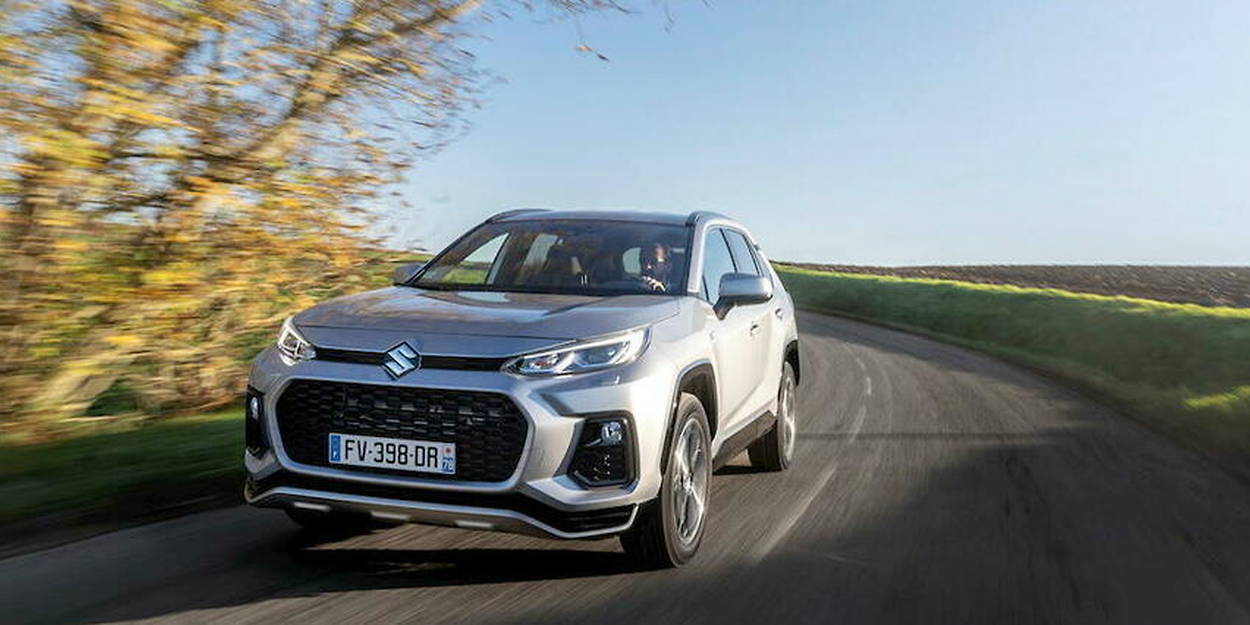EWhat if this top-of-the-range Suzuki had a little air of deja-vu? Where the Across pushes the plug a bit far is in appearances, totally saved to the point of not diverging from the original, the Toyota RAV 4. So what’s the point? It lies in the fact, for Suzuki, a specialist in compact formats, to have the top of the range that it lacked to complete a coherent offer of electrified vehicles. When the solutions are purely Suzuki, they often come from a high pragmatism which consists in offering the function without too much drifting the form. In other words, Suzukis often remain light cars despite the electric ballast.
For the Across where Suzuki is essentially content to badger a RAV 4 of excellent reputation, it is much less obvious with, under its angular cut-and-paste lines, almost two tons on the scale. This will not deceive any “suzukist”, to whom we do not do it. But, since it is a large plug-in hybrid vehicle unknown to the battalion, why not consider it for what it is, a real versatile family capable of aiming for a 100% electric range of 75 km and even 98 km? in the city ? Impressive and strategically savvy, as it makes it possible to offer a large, tax-free vehicle.
What changes
What’s new for this revamped Across – it’s been around since 2020 – is that it now comes with a 6.6kW on-board charger instead of 3.3kW. This allows the battery to be recharged at a terminal in less than three hours instead of five hours. Housed under the boot floor, which reduces its volume, the lithium-ion cells offer an energy capacity of 18.1 kWh. They power no less than three electric motors (two at the front and one at the rear providing 4-wheel drive without a mechanical shaft), whether or not associated with the internal combustion engine.
The transmission shifts, as needed, from 100% forward power (most cases) to 20% forward – 80% reverse – on a muddy steep slope, for example. With 182 horsepower at the front and 54 at the rear, plus 185 horsepower drawn from the four-cylinder 2.5-liter gasoline engine, we obtain up to 306 horsepower in cumulative power. This enticing team when all the horses are there is credited with an approved consumption of 1.0 l/100 km (WLTP mixed cycle), with CO emissions2 content at 22 g/km.
Brilliant, but a little flippant with reality? Reviled for their official consumption not reflecting reality, thermal cars can be jealous of electrified ones, which are, with impunity, much further from the official indication. But this is more the problem of the standard and the method of measurement than the responsibility of the manufacturers. It is worth checking out on the road, without illusions, of course.
life on board
Unsurprisingly, we find the very Japanese universe made of materials without charm but obviously designed to last, carefully assembled. Perched above the dashboard, the new central high-definition touch screen, 10.5′ instead of 9′, drives the many multimedia features. The GPS, on the other hand, is absent on the pretext that it would have displayed Toyota on ignition. A trainee computer scientist at Suzuki could have solved this in half a day, so you have to fall back on Apple Car Play connectivity to drive in a guided world.
On the other hand, you will always have to go wired to connect Android Auto… and thus use the smartphone’s GPS. At the high price of the Across, it’s a bit cavalier, even if the equipment is also very generous, especially in terms of driving aids. As for the digital instrument cluster, it now consists of a 12.3′ high-definition screen replacing the previous 7′ screen, which gives a more up-to-date look to a set with a rather conventional design.
The opinion of Point Auto
Like the RAV 4, the Across offers four driving modes: all-electric, automatic (especially electric), hybrid (mostly thermal) or forced battery charging with the 4-cylinder as a generator. Unless it is absolutely necessary to approach a low-emission zone, it is better to avoid the latter, which over-consumes, the automatic being the good choice on weekdays for the usual split journeys.
On weekends or for longer journeys, we will wake up the 4-cylinder, which, when the battery is empty, can only rely on itself. The Across loses its electric horsepower and its dynamism, but not so much if the profile of the road allowed it to soar. On the other hand, in the mountains or in sporty driving, it struggles more while an insistent right foot tends to spin the mechanics.
With more progressiveness and discernment – no need to press harder on the accelerator if nothing more comes – the result is rather convincing, with even an excellent fuel consumption of 6.4 l, making it possible to aim for 800 kilometers before supply both energies.
As the Across is very comfortable and fairly quiet in normal mode, which it reassures with serene road holding, there is only one question left to ask: why is it, at 59,290 euros, more expensive than who inspired it? Maybe because Toyota doesn’t give away freebies, including GPS.
MOST
– Convincing hybridization
– Very safe behavior
– Comfort and equipment
– Electric autonomy
THE LESSERS
– High price
– Lack of GPS
– Interior without cheerfulness
– Tendency to grind
